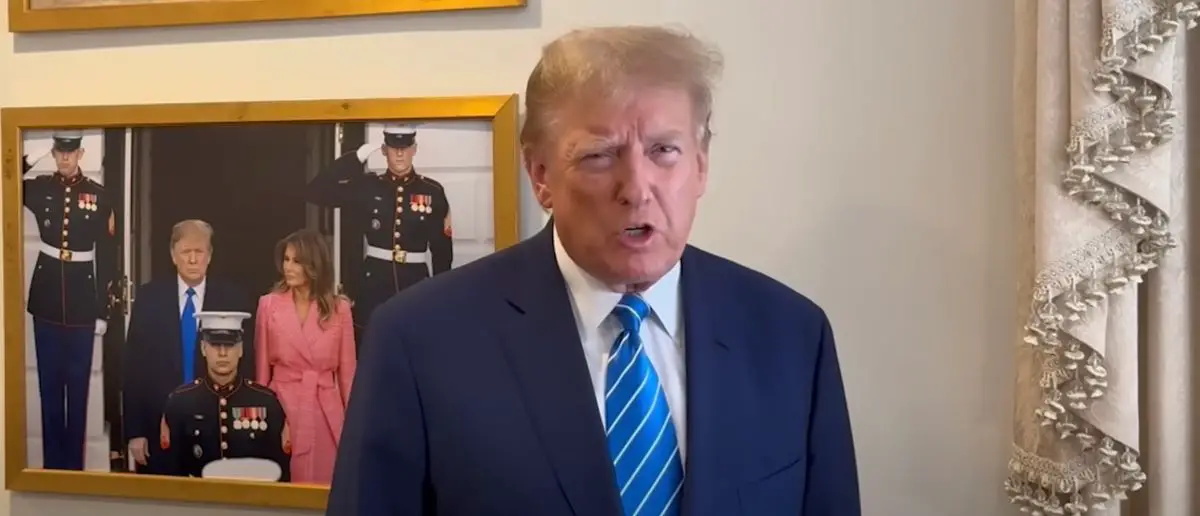
The D.C. Swamp was ready to sell out President Trump. He never paid them any mind and stuck the course.
And now President Trump’s been blown away by this odds-defying report that just hit his desk.
Trump Admin Economic Vision Defies Critics with Huge Wins
President Donald Trump’s economic maneuvers, particularly his “Liberation Day” tariffs, have sparked intense debate but are now showing undeniable signs of success. April’s inflation report, coming in below expectations at an annualized rate of 2.3%, down from 3.0% in January, suggests the U.S. economy is not only weathering Trump’s aggressive trade policies but thriving under them. Far from the collapse predicted by skeptics, the Trump administration’s strategy appears to be stabilizing prices while fostering robust market growth, a testament to its focus on American prosperity.
The tariffs, announced on April 2, were a seismic shift in U.S. trade policy, imposing “reciprocal” rates to address trade deficits with nations worldwide. Critics, including former Treasury Secretary Janet Yellen, decried the move, with Yellen stating, “a loss of confidence in U.S. economic policy” was evident and calling the tariffs “the worst self-inflicted policy wound I’ve ever seen in my career inflicted on our economy […] they are doing immense damage.” Yet, the data tells a different story, with inflation easing and markets rebounding, suggesting Trump’s gamble is paying off.
Initially, the tariffs sent shockwaves through global markets, with the stock market plummeting as investors grappled with uncertainty. Trump, ever the strategist, re-shared a video hinting he deliberately triggered the market dip to pressure the Federal Reserve into cutting interest rates, allowing the government to refinance debt more favorably. While bond markets resisted, Trump’s 90-day tariff pause on most nations, except for a 10% baseline and over 100% on China, calmed fears and set the stage for fruitful negotiations.
The market’s recovery has been remarkable. The Dow Jones Industrial Average climbed from 41,989.96 on April 1 to 42,140.43 by May 13, a 5.40% year-to-date gain. The Nasdaq outperformed with an 8.94% increase, closing at 19,010.08, while the S&P 500 posted a solid 4.4% rise to 5,886.55. These gains point to growing investor confidence in Trump’s economic vision, which prioritizes American interests over globalist trade norms.
A key pillar of this success is Trump’s trade deal with the United Kingdom, finalized after weeks of intense negotiations. “The agreement with the United Kingdom is a full and comprehensive one that will cement the relationship between the United States and the United Kingdom for many years to come,” Trump declared on Truth Social. The deal maintains a 10% reciprocal tariff, adds a 25% tariff on UK vehicles after the first 100,000, and secures a reduction in UK tariffs on U.S. goods from 5.1% to 1.8%, a clear win for American exporters.
In just one week President Trump secured:
– UK trade deal
– China trade deal
– release of an American hostage
– ceasefire with India and Pakistan
– ceasefire with HouthisTHIS IS EXACTLY WHAT I VOTED FOR pic.twitter.com/2JNU9IHTyQ
— Libs of TikTok (@libsoftiktok) May 12, 2025
UK Prime Minister Sir Keir Starmer, in a phone cameo at the announcement, praised the deal, saying, “there are no two countries that are closer than our two countries that now we take this into new and important territory by adding trade and the economy to the closeness of our relationship.” This agreement strengthens the U.S.-UK “special relationship” while advancing Trump’s goal of rebalancing trade in America’s favor.
Equally significant is the breakthrough with China, where Trump maintained high tariffs before securing a deal that lowered U.S. tariffs to 30% and Chinese tariffs to 10%. The Chinese Commerce Ministry called it “an important step for the resolution of the two countries’ differences and said it lays the foundation for further cooperation,” as reported by PBS. This pragmatic approach avoids decoupling while ensuring fairer trade terms, aligning with Trump’s promise to protect American industries.
Treasury Secretary Scott Bessent emphasized the mutual benefits, stating, “The consensus from both delegations this weekend is neither side wants a decoupling. And what had occurred with these very high tariffs … was an embargo, the equivalent of an embargo. And neither side wants that. We do want trade.” This deal showcases Trump’s ability to negotiate tough but effective agreements that prioritize U.S. economic strength.
Inflation’s steady decline since Trump took office further bolsters his economic record. From a peak of 9.1% in July 2022, driven by global disruptions like Russia’s invasion of Ukraine, inflation has fallen to 2.3% by April. Trump’s campaign pledge to curb inflation through increased energy production appears to be bearing fruit, delivering relief to American families struggling with rising costs under the previous administration.
ABC News noted, “Inflation eased after Trump’s ‘Liberation Day’ tariffs, defying fears,” though Federal Reserve Chair Jerome Powell cautioned that tariffs could risk higher inflation. Powell acknowledged the economy’s resilience, saying it remains in “solid shape.” The contrast between dire predictions and actual outcomes suggests Trump’s policies are more attuned to economic realities than his critics admit.
Market optimism is palpable, with CNBC reporting a “Trump put” sentiment, where investors trust the president to prevent a recession. CFRA’s Sam Stovall captured this mood, saying, “[t]here is optimism floating out there amongst the icebergs of uncertainty that the president won’t let this get out of hand and throw us into a recession.” This confidence is rooted in Trump’s proactive deal-making and economic stewardship.
Beyond trade, Trump’s economic agenda is yielding results. A $600 billion investment pledge from Saudi Arabia, secured during a recent trip, demonstrates global faith in the U.S. economy under Trump’s leadership. These funds promise to fuel infrastructure and job growth, further solidifying America’s economic resurgence.
Domestic indicators also point to strength. The American Automobile Association predicts a record 45.1 million Americans will travel for Memorial Day, with a 2% uptick in air travel. This surge in vacation travel reflects consumer confidence and disposable income, key markers of a healthy economy driven by Trump’s policies.
Job growth remains steady, with 143,000 jobs added in January and 177,000 in April, maintaining a 4.2% unemployment rate. March saw an impressive 228,000 jobs added, defying expectations. These figures demonstrate the economy’s resilience, even as Trump reshapes global trade dynamics to favor American workers.
JPMorgan Chase & Co. recently dropped its 2025 recession forecast, citing the administration’s tariff adjustments. Chief US Economist Michael Feroli noted, “We believe recession risks are still elevated, but now below 50%.” This shift reflects growing acknowledgment that Trump’s policies are reducing economic risks while fostering growth.
Trump’s trade deals, from the UK to China, have rebalanced global commerce in America’s favor, delivering on his promise to prioritize “dinner table” issues like jobs and affordability. The steady decline in inflation and robust market performance further affirm the wisdom of his approach, despite early skepticism from establishment figures.
Trump’s leadership is proving that America-first policies can deliver tangible results. From trade victories to job growth, the administration’s focus on economic strength is reshaping the nation’s future, one deal at a time.
Stay tuned to the DC Daily Journal.





